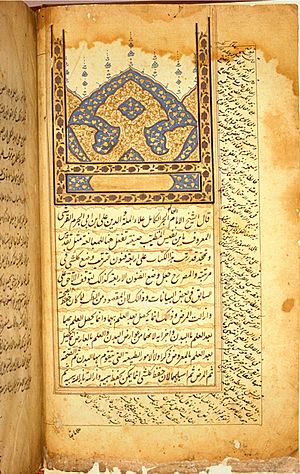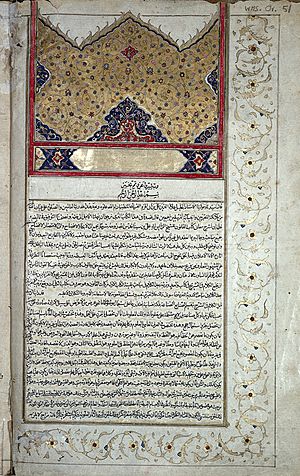Ibn al-Nafis facts for kids
Quick facts for kids Ibn al-Nafis |
|
|---|---|
 |
|
| Religion | Islam |
| Personal | |
| Born | 1213 |
| Died | Cairo, Egypt |
| Religious career | |
| Works | Commentary on Anatomy in Avicenna's Canon |
| Influenced | Abu Hayyan Al Gharnati |
Ibn al-Nafis (full name: Ala-al-Din abu al-Hasan Ali ibn Abi-Hazm al-Qarshi al-Dimashqi) was a brilliant Arab scholar who lived during the Islamic Golden Age. He was a true "polymath," meaning he was an expert in many different subjects. His main interests included medicine, surgery, physiology (how the body works), anatomy (the structure of the body), biology, Islamic studies, jurisprudence (law), and philosophy.
Ibn al-Nafis is most famous for being the first person to accurately describe how blood flows through the pulmonary circulation (the path from the heart to the lungs and back). This discovery happened long before William Harvey's work in 1628. Before Ibn al-Nafis, the ancient Greek physician Galen's ideas about blood circulation were believed for centuries. Ibn al-Nafis challenged these old ideas, which is why he is sometimes called "the father of circulatory physiology."
He also performed human dissections to learn more about the body. Through this, he made important discoveries about coronary circulation (blood flow to the heart muscle) and capillary circulations (tiny blood vessels). He even became the chief doctor at the al-Naseri Hospital in Cairo, Egypt. Besides medicine, Ibn al-Nafis was also an expert in Islamic law and wrote over 110 medical textbooks!
Contents
The Life of Ibn al-Nafis
Ibn al-Nafis was born in 1213, likely in a village near Damascus, which is now in Syria. As a young person, he studied religion, philosophy, and literature. When he was 16, he began studying medicine at the Nuri Hospital in Damascus. He spent more than ten years learning there. His teachers included famous doctors like Al-Dakhwar.
In 1236, Ibn al-Nafis moved to Egypt at the request of the ruler, Sultan al-Kamil. He became the chief doctor at al-Naseri Hospital, which was founded by Saladin. Here, he taught and practiced medicine for many years. One of his well-known students was a Christian doctor named Ibn al-Quff. Ibn al-Nafis also taught Islamic law at a school called al-Masruriyya Madrassa. This shows how highly he was respected in both medicine and religious law.
Ibn al-Nafis lived most of his life in Egypt. He saw big historical events, like the fall of Baghdad and the rise of the Mamluks. He even became the personal doctor for Sultan Baibars and other important leaders. This shows how skilled and trusted he was as a physician. Later in his life, at 74 years old, he became the chief doctor at the new al-Mansori Hospital, where he worked until he died.
Ibn al-Nafis passed away in Cairo after a short illness. Before he died, he gave his house and his large library to the Qalawun Hospital.
His Important Writings

One of his biggest books is called Al-Shamil fi al-Tibb, which means "The Comprehensive Book on Medicine." He planned for it to be a huge encyclopedia with 300 volumes. However, he only finished 80 volumes before he died. Even so, it is still one of the largest medical encyclopedias ever written by one person. It summarized all the medical knowledge in the Islamic world at that time. Ibn al-Nafis left this encyclopedia and all his other books to the Mansoory Hospital.
Over time, many parts of this encyclopedia were lost. Only two volumes still exist in Egypt today. Scholars are working to find and study the other parts of this important work, which are in libraries around the world.
Discoveries About the Body
In 1924, an Egyptian doctor named Muhyo Al-Deen Altawi found an old book by Ibn al-Nafis. It was called Sharh tashrih al-qanun li’ Ibn Sina, or "Commentary on Anatomy in Avicenna's Canon." This book explained anatomy, pathology (diseases), and physiology in great detail. It contained the earliest known description of how blood flows through the lungs.
How Blood Flows Through the Lungs
Before Ibn al-Nafis, the most common idea about how the heart worked came from Galen. Galen believed that blood went from the right side of the heart to the left side through tiny, invisible holes in the heart's wall (called the septum). He thought the blood then mixed with air to create a "spirit" that was sent to the body.
Ibn al-Nafis disagreed with Galen's idea. He studied the heart and found that there were no holes in the septum. He wrote: "The blood, after it has been refined in the right cavity, must be transmitted to the left cavity where the (vital) spirit is generated. But there is no passage between these cavities, for the substance of the heart is solid in this region and has neither a visible passage... nor an invisible one which could have permitted the transmission of blood, as was alleged by Galen."
Instead, Ibn al-Nafis correctly suggested that blood from the right side of the heart travels to the lungs through the pulmonary artery. In the lungs, the blood mixes with air. Then, this blood (now with oxygen) returns to the left side of the heart through the pulmonary vein. This is the correct path of blood through the lungs, known as pulmonary circulation.
He explained: "Blood from the right chamber of the heart must arrive at the left chamber, but there is no direct pathway between them. The thick septum of the heart is not perforated... The blood from the right chamber must flow through the vena arteriosa (pulmonary artery) to the lungs, spread through its substances, be mingled there with air, pass through the arteria venosa (pulmonary vein) to reach the left chamber of the heart, and there form the vital spirit...."
Blood Flow to the Heart Itself
Ibn al-Nafis also figured out that the heart gets its own food and oxygen from special blood vessels called coronary arteries. He said that the heart is not fed by blood inside its chambers, but by blood flowing through these specific vessels that go into the heart muscle.
Tiny Blood Vessels (Capillaries)
Ibn al-Nafis had an early idea about capillary circulation. He thought there must be tiny connections or "pores" between the pulmonary artery and vein in the lungs. This idea came more than 400 years before capillaries were actually discovered! However, his idea was only about the lungs, not the whole body.
How the Pulse Works
Ibn al-Nafis also disagreed with Galen about the pulse. Galen thought the pulse came from the arteries themselves. Ibn al-Nafis believed that the pulse was a direct result of the heart beating. He noticed that arteries expand and contract at different times depending on how far they are from the heart. He also correctly observed that arteries contract when the heart expands, and expand when the heart contracts.
Understanding the Lungs
When describing the lungs, Ibn al-Nafis said: "The lungs are made of parts: the bronchi (airways), branches of the arteria venosa (pulmonary vein), and branches of the vena arteriosa (pulmonary artery). All these are connected by loose, spongy tissue. The lungs need the vena arteriosa to bring blood that has been thinned and warmed in the heart. This blood seeps through tiny pores into the air sacs of the lungs, mixes with air, and then becomes fit to be spirit when it reaches the left side of the heart. This mixture is carried to the left side by the arteria venosa."
He also noted that some blood was filtered through the coverings of the vessel that brought blood to the lungs from the heart. This vessel is now called the pulmonary artery.
The Brain's Role
Ibn al-Nafis was one of the few doctors at his time who believed that the brain, not the heart, was the organ responsible for thinking and feeling.
Other Medical Work
Studying the Body (Dissection)
There is some discussion about whether Ibn al-Nafis performed human dissections. At that time, Islamic law generally discouraged dissection. However, his detailed discoveries about the heart and blood flow suggest he must have either dissected human bodies or seen them during surgical operations. Some scholars believe his findings are so precise that he had to have performed dissections, even if he wrote that he was prevented from doing so.
Kidney and Bladder Health
In his book "Al-Mugiza," Ibn al-Nafis explained the differences between kidney stones and bladder stones. He also talked about kidney and bladder infections, different types of swelling in the kidneys, and ways to manage kidney stones without surgery, including using medicines.
Surgery Methods
In his book Kitab al-Shamil, Ibn al-Nafis shared his ideas about surgery. He described three steps for a surgical procedure:
- Step 1: Before Surgery He believed doctors should explain to the patient what the surgery would involve and why it was needed.
- Step 2: During Surgery This was the actual operation.
- Step 3: After Surgery This involved follow-up appointments and regular check-ups for the patient.
He also wrote about how surgeons should work with nurses, patients, and other surgeons.
Metabolism
Ibn al-Nafis was also the first to describe the idea of metabolism. This is the process where the body constantly breaks down and builds up substances. He said: "Both the body and its parts are in a continuous state of dissolution and nourishment, so they are inevitably undergoing permanent change."
His Ideas on Philosophy and Religion
Ibn al-Nafis's philosophical ideas are mostly found in his book, Theologus Autodidactus. This book is a philosophical novel that explores many topics like how the universe began (cosmology), how we gain knowledge (epistemology), and the future. It tells the story of a child who grows up alone on a desert island and how his mind develops when he meets the outside world.
This novel was written as a response to another famous Arabic novel, Hayy ibn Yaqdhan. Ibn al-Nafis used his story to defend Islamic beliefs about prophets, laws, and the idea of resurrection after death. He used logical arguments and scientific ideas to explain these religious concepts. Some scholars even consider Theologus Autodidactus to be one of the earliest science fiction works.
Unlike some thinkers who believed the soul came from the heart, Ibn al-Nafis argued that the soul is connected to the entire body, not just one part. He believed the soul is what a person means when they say "I."
His Lasting Impact
Ibn al-Nafis was a master of medical science and wrote many books. He was also a deeply religious scholar. Because of this, later Muslim historians and biographers greatly admired him. Some even called him "the second Ibn Sina" (another very famous physician).
For a long time, the ideas of Galen dominated medicine. What made Ibn al-Nafis special was his courage to challenge Galen's work. He studied Galen's system but also criticized it, forming his own new medical theories.
Ibn al-Nafis's importance in the history of medicine was not fully known in the Western world until the early 20th century. Since then, people have re-evaluated his work and realized how advanced his observations were, especially his understanding of how the body works.
Many science historians now see Ibn al-Nafis as "the greatest physiologist of the Middle Ages." George Sarton, a famous historian of science, said that if Ibn al-Nafis's theory was confirmed, his importance would "increase enormously" because he would be seen as a major forerunner to William Harvey.
Images for kids
See also
 In Spanish: Ibn Nafis para niños
In Spanish: Ibn Nafis para niños



